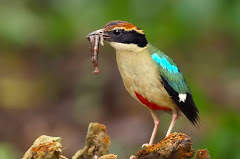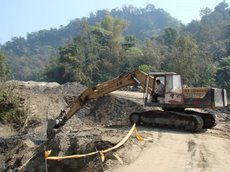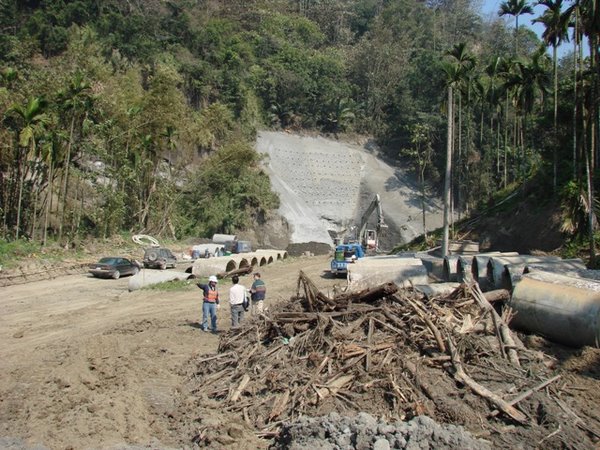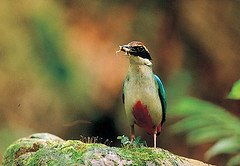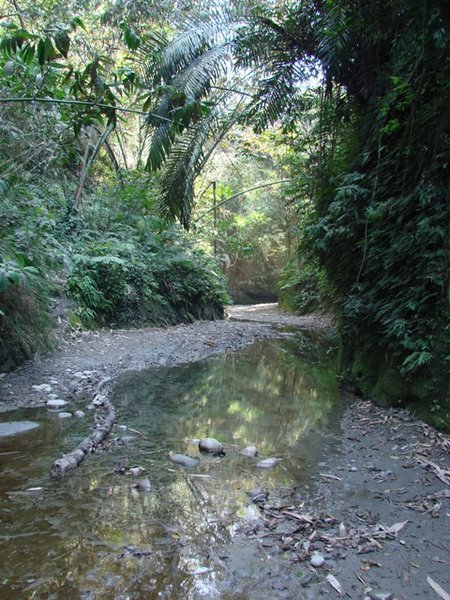Taiwan National Coalition Against the Hushan Dam
Plans were first laid to submerge You-cing Valley in December 1994. Located in the Hushan area, 10 km south-east of Douliu City in Yunlin County, the valley would be filled with water diverted from the Cing-shui River and dammed just north of Hushan Village. The resulting reservoir would, according to developers, provide the means to relieve Yunlin County of its shortage of agricultural and domestic water, and mitigate the serious land subsidence that had occurred through excessive pumping of groundwater. More than ten years later, however, the dam still exists only on paper, and a growing number of people are fighting to keep it that way.
You-cing Valley: Wild at Heart
You-cing Valley carves a winding path through lush forest that has survived and replenished itself since the last major forestry exploitation in the area by the former KMT government after 1949. Protected by law in recent years under the management of the Forestry Bureau, the valley offers more than a shady walk for people escaping the stress of the city; birdwatchers and academics have recorded a wealth of animal species to whom the plants and pools provide either a permanent home, or a vital resting and breeding ground along migration routes.
The diversity of life in Hushan presents itself throughout the day as a vibrant spectrum of sounds and colors. The hiss and hum of cicadas and bees resonate from amidst flowers, leafy green vegetation and creaking bamboo, punctuated by the various taps, whistles and squeaks of birds including the Taiwan Partridge Arborophila crudigularis and Swinhoe's Pheasant Lophura swinhoii, two of six endemic bird species recorded in the area. A gradually mounting chorus of croaks and rattles hints at the vast concealed army of resident amphibians; 21 of Taiwan’s 31 frog species have been spotted at Hushan. And in early April, dense clouds of Taiwan Purple Crow Butterflies (Euploea tulliolus) can be seen taking off as they begin their northward migration.
Brown tree frog: Wild Bird Society of Yunlin
One particularly striking bird, the Fairy Pitta Pitta nympha, finds its way to You-cing Valley every year from countries such as Malaysia and Indonesia. Known in Mandarin as the "Eight-colored Bird", it arrives in late spring, and is seen hopping along the ground looking for earthworms, its multi-colored feathers gleaming brilliantly when caught the sunlight. Threatened by habitat destruction, only about 3,000-5,000 Fairy Pitta remain worldwide. It is listed as a vulnerable bird by Birdlife International and the International Union for the Conservation of Nature (IUCN), and regulated under the Convention on International Trade in Endangered Species (CITES), and is listed as an endangered species in Taiwan, where Hushan provides the world’s most densely populated Fairy Pitta habitat known to date.
Fairy Pitta: Wild Bird Society of Yunlin
International recognition of this shrinking population brought Birdlife International representatives to Taiwan in 2000 to voice concern over exploitation of local forest resources. Later, in 2004, in a letter addressed to President Chen Shui-bian, the organization's director, Mike Rands, asked that the government confer greater protection status on the Fairy Pitta habitat. Specifically addressing the Hushan dam proposal, Rands also echoed Taiwanese environmentalists in asking that a new Environmental Impact Assessment (EIA) of the project be conducted, taking into consideration the importance of the area's ecosystems, as well as the viable, low cost alternatives that had been suggested in place of the dam.
However, even with protection under the law and the work of activists at home and abroad, rich ecosystems such as that of You-cing Valley are not out of danger; the growing pressure of corporate and political interest in the Hushan dam project led in January 2005 to agreement by the Forestry Bureau to release the land from under its control, making it available to developers. Water shortages and subsidence in Yunlin County were again cited as grounds for urgency in approving and starting construction. However, whether or not the dam was a viable solution to Yunlin’s water problems remained the subject of heated debate, and according to many who had studied the valley environment, it would even be a highly dangerous project.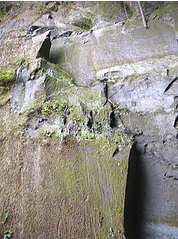
Valley Walls: Wild at Heart
From a distance, the walls of the valley appear strong and solid. However, as demonstrated repeatedly by ecologists visiting the area, the stone breaks off easily and turns to powder between the fingers. The September 1999 earthquake, which had a magnitude of 7.3, and subsequent typhoons have caused the fragile hillsides to collapse, clogging the Cing-shui River and turning one upstream lake into a mud plain. A small weir built in an attempt to control the flow of sand now stands silted up to the brim, and some say the same fate lies in store for the Hushan dam, estimating a lifespan of only ten to 20 years. The original EIA, opponents argue, not only overlooked the biodiversity of the area; it also failed to address the potential silting up of the dam, and the fact that an earthquake on a similarly large scale could cause it to collapse.
Silted-up weir, You-cing Valley: Wild at Heart
To concerned locals and environmental groups, however, this was only part of a much larger issue. At the same time as government agencies were endorsing the dam project as a solution to Yunlin's existing water problems, separate plans were being laid for two major construction projects on Yunlin's offshore business park. Two corporations were vying for space to set up factories--Formosa Plastics for a steelworks, and Chinese Petroleum Corporation for a petrochemical science and technology park. The January 2005 decision to release the Hushan area from the protection of the Forestry Bureau coincided with a report confirming the suspicions of environmental groups that the offshore construction projects were linked to the dam project; the Ministry of Economic Affairs revealed that the corporations would both be allowed to build factories, and the dam would be built to meet an enormous future demand for water by these two notorious polluters. Further development along the west coast will also spell disaster for Taiwan's unique and highly threatened population of Indo-Pacific humpback dolphin.
Mailiao, Yunlin, Home of Formosa Plastics' Sixth Naptha Cracker Plant: Li Gen-jheng
To residents of Yunlin who trust in the promotional information they have received, the project still represents a solution to their water needs. Those who do not live near Hushan do not feel threatened by the potential collapse of the dam--and why should there be concern, when the engineers are so confident in their ability to overcome the forces of nature that they see no need to disclose their solutions for public review? But to those who have studied the ecology and geology of the proposed dam site, and the health and environmental effects of factories such as those planned for the business park, the risks and sacrifices involved in the Hushan dam project far outweigh the benefits of channeling more of the county's scarce resources into the hands of a few powerful corporations.
A comprehensive report on the Hushan Dam project is available in Mandarin at the Ecological Education Center. An excerpt of this book is also available in English.
Help Save The Fairy Pitta
Voice your concern for the Fairy Pitta by sending a Letter of Concern to the Taiwan Government and help us stop the Hushan Dam.
Monday, April 30, 2007
The Hushan Dam Project
Posted by
psilotum
at
2:06 AM
1 comments
![]()
Threatened Birds of Huben-Hushan Area
Taiwan National Coalition Against the Hushan Dam
Important Bird Areas in Asia
More than one quarter of the world’s bird species are found in Asia. That means that Asia supports over 2,700 bird species. Three hundred and thirty-two of those species are threatened with global extinction. The greatest threat faced by birds is the loss of habitat and as Asia develops suitable habitat is disappearing at an alarming rate.
Birdlife International is the largest global network of non-governmental conservation organizations with a special focus on birds (Birdlife, 2004, p 1). Birdlife International (formerly known as the International Council for Bird Preservation, or ICBP) started to develop the IBA or Important Bird Area program in the mid-1980s. Basically the program identifies a network of globally important areas for the conservation of birds and their habitats using standard, internationally-agreed criteria.
Taiwan has a total of 53 IBAs. For its size, Taiwan has a very high number of IBAs. Only 11 or 21% fall within totally protected areas. 17 IBAs or 32% fall within partially protected areas. That leaves 25 or 47% of Taiwan’s IBAs without any protection. Huben is one of the IBAs without any protection.
Status of the Huben Area
The Huben-Hushan area has been internationally identified as an IBA or Important Bird Area and is listed as one of Asia’s key sites for conservation (Birdlife, 2004, p 94). The details of the Huben IBA are as follows:-
Important Bird Areas in Taiwan.
Number: TW017.
Category: A1.
Admin Region: Yunlin.
Coordinates: 23° 43’N 120° 36’E.
Altitude (highest point): 519m.
Area: 2,200 ha.
Habitats: Artificial landscapes (terrestrial); Forest.
Threatened Species: Fairy Pitta Pitta nympha.
Protected Area Status of the IBA: Unprotected.
A Hushan Stream-Wild at Heart
The Major Threats to the Huben-Hushan Area
Much of the area is threatened by the proposed construction of the Hushan Dam Project. Other smaller development projects, gravel extraction, and irresponsible land-use have also resulted in the loss of valuable habitat within and around the Huben IBA.
Hushan Dam Project-Wild at Heart
Hushan Dam Project-Wild at Heart
Threatended Species in the Huben-Hushan Area
1. Taiwan Partridge Arborophila crudigularis (Swinhoe 1864) Endemic to Taiwan.
Threatened Species Category: Globally Threatened Species.
IUCN Red List Category: Near Threatened.
Protection: Legally protected in Taiwan.
Status in Huben-Hushan Area: Resident.
2. Swinhoe’s Pheasant Lophura swinhoii (Gould 1863) Endemic to Taiwan.
Threatened Species Category: Globally Threatened Species.
IUCN Red List Category: Near Threatened.
Protection: CITES appendix 1. Legally protected in Taiwan.
Status in Huben-Hushan Area: Resident.
Swinhoe’s Pheasant. Photo courtesy of Richard Yu
3. Maroon Oriole Oriolus traillii ardens (Swinhoe 1862) Endemic Subspecies.
Threatened Species Category: Nationally Threatened Species.
IUCN Red List Category: Endangered.
Protection: Legally protected in Taiwan.
Status in Huben-Hushan Area: Resident.
Maroon Oriole. Photo courtesy of Richard Yu
4. Fairy Pitta Pitta nympha (Temminck & Schlegel 1850) Summer breeding resident.
Threatened Species Category: Globally Threatened Species.
IUCN Red List Category: Vulnerable.
Protection: CITES appendix II. Legally protected in Taiwan.
Status in Huben-Hushan Area: Summer breeding resident.
Fairy Pitta. Photo courtesy of Richard Yu
Huben-Hushan Species Listed on the Taiwan Red Data Watch List
- Malayan Night Heron Gorsachius melanolophus (Raffles 1822) Resident.
- Peregrine Falcon Falco Peregrinus (Tunstall 1771) Rare Visitor.
- Slaty-legged Crake Rallina eurizonoides (Lafresnaye 1845) Probably Resident.
- Ruddy-breasted Crake Porzana fusca (Linnaeus 1766) Resident.
- Red Collared-Dove Streptopelia tranquebarica (Hermann1804) Resident.
- Emerald Dove Chalcophaps indica (Linnaeus 1758) Resident.
- Common Kingfisher Alcedo atthis (Linnaeus 1758) Resident.
- Ruddy Kingfisher Halcyon coromanda (Latham 1790) Passage Migrant.
- Varied Tit Parus varius (Temminck & Schlegel 1848) Rare Visitor.
- Golden-headed Cisticola Cisticola exilis (Vigors & Horsfield 1827) Probably Resident.
- Oriental Skylark Alauda gulgula (Franklin 1831) Visitor.
Future Taxonomy changes concerning Endemic subspecies
It should be noted that a number of the endemic subspecies found in the Huben IBA will in all probability be raised to full endemic species status in the near future and the threats to these new endemics will have to be assessed. Species to be considered are:
Black-browed Barbet Megalaima oorti nuchalis
Rusty-cheeked Scimitar Babbler Pomatorhinus erythrogenys erythrocnemis
(Race erythrocnemis often placed under P. erythrocnemis Spot-breasted Scimitar Babbler)
Streak-breasted Scimitar Babbler Pomatorhinus ruficollis musicus
Bird List
Hushan-Hushan Bird List
Huben-Hushan Bird List-Download
References
Birdlife International, Important Bird Areas in Asia. Key Sites for Conservation (Wakefield, UK, H.Charlesworth & Co, 2004).
Collar. Spotlight on Taiwan. Endemic Subspecies of Taiwan Birds (Bedford, UK. Birding Asia No.2, December 2004).
Fang, A Guide to Threatened Birds of Taiwan (Taipei, Mao-tou Ying, 2005).
MacKinnon & Phillipps, A Field Guide to the Birds of China (Oxford, Oxford University Press, 2000).
Wu, et al, A Guide to the Wild Birds of Taiwan (Taipei, Taiwan Wild Bird Information Centre and Wild Bird Society of Japan, 1991). (in Mandarin)
Posted by
psilotum
at
1:37 AM
1 comments
![]()
The Fairy Pitta in Taiwan: information sheet
Taiwan National Coalition Against the Hushan Dam
Fairy Pitta: Wild Bird Society Yunlin
A beautiful, brilliantly coloured, sparkling little migratory songbird called the Fairy Pitta comes to the Huben-Hushan area in Yunlin County every year to breed. Some of its most lush habitat is under threat of being inundated for the sake of the The Hushan Dam Project, which will supply water primarily to two highly polluting new industrial complexes on the west coast. While Taiwan's Humpback dolphin Sousa chinesis and an long list of other species that will also feel the effects of the resulting changes in fresh water flow, loss of habitat and the pollution that will be caused by the factories, we have neither the manpower nor, for all we know, the capacity on our server to write in detail about all of those in danger, so here is just a little about the Fairy Pitta.
Also, if you sympathise with our protest against the Hushan Dam project, you can help us by sending a Letter of Concern to the Taiwan Government. The movement against this project is a joint effort by numerous environmental groups and individuals across Taiwan, and although the voices calling for construction are loud and backed with more money than we could ever imagine, we are still hearing encouraging noises from many people interested in helping and we are still fighting to save the area and its inhabitants.
Distribution
The Fairy Pitta Pitta nympha is one of several species previously known collectively as the Indian Pitta*. It belongs to the Pittidae family of the order Passeriformes. A migrant songbird, it is distributed across areas of Borneo in the winter, and flies to Taiwan, South Korea, Japan and Southeastern China to breed in the summer.
The Pitta nests in many parts of Taiwan. The Huben area in Yunlin County has records of consistently large numbers, and is believed to be the most densely populated Pitta habitat in the country.
Nesting and breeding in Taiwan
Adult Pitta arrive in Taiwan in early April to reclaim familiar old breeding grounds, and return with their young to their wintering grounds in Autumn. The peak breeding season is in May and June, and it is from late April until early May that the male Pitta’s call can be heard most frequently - two consecutive notes with an interval of a semi-tone or a whole tone. This serves as both a mating call and as a territorial warning signal to other males. It can be heard calling up to a mile away in the forest.
A pair of Pitta will build their nest using bamboo leaves, plant fibres, twigs and small branches, and will line it with soft mosses and plant fibres. It is compact and round, with the entrance on one side, and the colours of the materials selected provide an effective camouflage. They may choose to build it in the crevices of tree roots or rocks on the steep, dark, moist slopes of a mountain ravine, or higher up in the foliage at the top of a tree trunk, at heights ranging from one to five meters above the ground.
The entrance, however, will be placed in a spot without much vegetation, for ease of access, and to avoid attack by predators that could conceal themselves amongst leaves.
Caution is also exhibited each time the Pitta returns to its nest throughout the breeding process. It will often perch nearby, scanning the area for danger, and then take an indirect flight path back to the nest.
After split-second copulation, the female will form and lay an egg every day. She will usually lay four or five, while six eggs are possible but very rare. She and her mate will wait until she has laid her last egg before taking turns to incubate them, a process that lasts two weeks. In this way they can be sure that all eggs will hatch at the same time, which is more efficient and less troublesome for the pair than if they were to hatch separately, as much energy must be spent searching for food as soon as the young have hatched.
Raising the young
Throughout the following weeks, the parents continue to exercise caution by removing from the nest any sources of odor that might attract predators. For example, they will eat the shells of the newly-hatched young, as well as their partially-digested feces, and once the young are able to fully digest their food, the parents will remove the feces to a place far from the nest.
As soon as the eggs are hatched, the parents share the work of looking for food and caring for the hatchlings. The main diet of the Fairy Pitta is earthworms, for which they rummage in the soil, but they are also known to eat other insects as well as snakes, lizards and small rodents. They will forage in a territory of three to ten hectares, depending on the abundance of food.
Feeding become busier as the young grow larger and hungrier, as well as during the sudden, heavy rain storms that often occur during this period, which coincides with Taiwan’s “plum rain season” (mei-yu-ji), with the drop in temperature increasing the fledglings’ appetite.
Eventually, after two weeks of growth and wing formation, the parents will use earthworms as bait to coax the young out of the nest, encouraging them to take flight and start foraging for themselves.
Eight Colours
Known in Mandarin Chinese as the “Eight-colour bird” (ba-se-niao), the Fairy Pitta is best-known for its beautiful colouring. Aside from white, two shades of brown, green, yellow, black and a red pigment on the underside, it is the striking, shiny blue on its wings that has earned it another nickname – the “jewel” of the forest. It is believed that this glittering effect is caused by a layering in the wing feathers.
The light and dark brown patterning on the top of the head provides a leaf-like camouflage at the entrance to the nest as the parents incubate the eggs. The young, too, are protected by darker, less eye-catching colours such as browns and black. A larger white wing spot distinguishes the male from the female.
Neighbours and Natural Enemies
Malayan Night Heron: Wild Bird Society of Yunlin
The Malayan Night Heron Gorsachius melanolophus and the Emerald Dove Chalcophaps indica also forage the dark forest undergrowth in places such as Huben. One ubiquitous plant, the Giant Elephant Ear Alocasia macrorrhiza provides a juicy red fruit of which the Emerald Dove is particularly fond.
The Asian Crested Goshawk Accipiter trivirgatus, with its keen eyesight, is the principle natural enemy of the brilliantly coloured Fairy Pitta. Snakes are also a threat, as are ants, which can invade an unguarded nest and kill the young.
Crested Goshawk: Photo courtesy of Richard Yu
Threats
The main threat to the Fairy Pitta is habitat destruction. Most of the Pitta’s lower-elevation habitat has already been destroyed for human development. The Huben area in Yunlin County has also suffered in recent years from gravel extraction, which has stimulated protest amongst people concerned for the survival of animals such as the Pitta.
Hills in Huben left to erode after gravel extraction: Wild at Heart
Protests by locals including village warden Yin Lin-in, now a Yunlin County legislator and an active opponent of the Hushan Dam project have helped bring gravel exploitation in check, but not before large sections of hillside, including stream areas important to the Pitta, had been stripped of vegetation and mined. The scars of mining and the resulting erosion are still evident. It was this issue that first brought a BirdLife International team to Taiwan to express concern about the Pitta habitat.
Presently the greatest threat to the Pitta population in Huben is the controversial Hushan Dam project, which threatens to submerge 422 hectares of lush habitat.
However, other problems persist, notably the intrusion of photographers directly into the breeding areas of the Pitta during the critical breeding weeks.
Photographer climbs out of section of valley in which several Fairy Pitta are known to nest (29.4.06 - mating season): Wild at Heart
Forest destruction in Fairy Pitta wintering area of Borneo is also believed to pose a great threat to the survival of the species.
Status:
Taiwan: rare and endangered.
Birdlife International: vulnerable
IUCN: vulnerable
CITES: regulated
* Species previously all known as the Indian Pitta Pitta brachyura are now categorized as a superspecies group: Indian Pitta P.brachyura, Mangrove Pitta P.megarhyncha, Blue-winged Pitta P.moluccensis, and Fairy Pitta P.nympha.
Sources:
Interviews with members of the Wild Bird Society of Yunlin, 29 April 2006.
Pitta, the fairy of the forest, DVD, TESRI
Also see:
Birding in Taiwan and Yunlin County
Birding in the Huben-Hushan Area
Huben Bird Stories
Threatened Birds of the Huben-Hushan area
Hushan Bird List
Hushan Mammal List
Hushan Frog List
Hushan Reptile List
Endemic Species & Subspecies of Hushan: Mammals, Reptiles & Amphibians
Fairy Pitta Gallery
Fairy Pitta Video
Recently Published Papers on the Fairy Pitta
Posted by
psilotum
at
1:10 AM
0
comments
![]()
BirdLife Letter to Taiwan President
BirdLife Letter to Taiwan President
Letter to President Chen Re: the Fairy Pitta
Chen Shui-Bian,
President of the Republic of China
Re: Impact of Hushan dam project on Huban Important Bird Area
Honorable Sir,
BirdLife International is a global alliance of conservation organisations working together for the world's birds and people in over 100 countries worldwide. Globally, BirdLife International has over 2,500,000 members.
Between 4 and 8 November 2004, the Asia Partnership of BirdLife International held its Council Meeting in Taipei, Taiwan. At this meeting, BirdLife International was concerned to learn about a proposed dam project at Hushan village, Douliu city, Yunlin County, Taiwan.
Hushan village lies within Huban Important Bird Area, one of 53 sites in Taiwan identified as being of international importance for birds and biodiversity by Wild Bird Federation Taiwan (the BirdLife Partner). The Hushan area supports one of the most significant examples of lowland evergreen forest remaining in Taiwan. Recent surveys have shown the area to be of global importance for biodiversity. The Hushan area supports a population of Fairy Pitta Pitta nympha, a species recognised by IUCN (the World Conservation Union) as threatened with extinction globally. The population of Fairy Pitta at Hushan numbers at least 150 individuals, making it one of the most important in the world. In addition, the Hushan area supports five bird species endemic to Taiwan.On behalf of BirdLife International and the BirdLife Asia Partnership, I would like to respectfully express my concern about the potential impacts of the proposed dam project at Hushan village on the rich lowland evergreen forest ecosystem. In particular, I am concerned that the Environmental Impact Assessment (EIA) for the proposed dam did not mention the global importance of the site for Fairy Pitta. In addition, I am concerned that the EIA did not consider certain low cost, low impact, viable alternatives to the dam, which have been proposed.
I would like to respectfully propose that the Government of the Republic of China ensures that a comprehensive EIA of the proposed Hushan dam project is conducted. This EIA should consider more fully the potential impacts of the project on the population of Fairy Pitta and the lowland evergreen forest ecosystem at Hushan village, and take into account new proposed alternatives, such as construction of a groundwater pathway along the Chingshiu River. Moreover, I would like to propose that the Government of the Republic of China assesses the feasibility of conferring appropriate protection status on Huban Important Bird Area.
Yours faithfully,
Mike Rands
Director and Chief Executive
BirdLife International
Posted by
psilotum
at
12:28 AM
0
comments
![]()
Letter of Concern
This letter campaign has ended.
Hushan Dam Letter of Concern- your help is needed!
The Hushan dam project threatens to submerge 422 hectares of beautiful forested land, and with that the homes of hundreds of plant and animal species in this biologically rich area in Yunlin County, Taiwan. Although it was originally claimed that the dam was necessary to solve Yunlin's water shortage and land subsidence problems, it is now certain that this was untrue, and that most if not all the water will actually go to new industrial developments that will greatly increase the already serious pollution of the surrounding water, soil and air.
You can help us save Hushan by e-mailing this letter of concern to the Taiwan President and other politicians listed within.How to send:
Please feel free to write your own letter or cut and paste the following letter and add your name, location and organization (feel free to add your own comments), and email it to President Chen Shui-bian.
To: oop62@mail.oop.gov.tw, abian@mail.oop.gov.tw
cc:
eyemail@eyemail.gio.gov.tw, ylhga001@mail.yunlin.gov.tw, ly10998a@ly.gov.tw, coa@mail.coa.gov.tw, service@forest.gov.tw, dois@moea.gov.tw, foreign@dpp.org.tw, epm@epa.gov.tw, san@wracb.gov.tw, comment@wildatheart.org.tw, keephushanwild@gmail.com
(For your information the cc recipients are: Premier Chang Chun-hsiung(Confirmation email will be sent--respond by clicking the left icon), DPP-Frank Hsieh, Yunlin County Commissioner Su Chih-fen, Taiwan Solidarity Union Legislator Yin Ling-ying, Department of Investment Services, Council of Agriculture, Forestry Bureau, Environmental Protection Administration, Central Region Water Resources Office, Wild at Heart Legal Defense Association, Taiwan National Coalition Against the Hushan Dam.)
_________________________________________________
Letter of Concern
Re: The Hushan Dam Project
The President of the Republic of China,
President Chen Shui-bian.
Dear Sir,
I am writing to urge the cancellation of the proposed dam project at Hushan Village, Yunlin County, Taiwan.
The Huben-Hushan area is the world's most densely populated habitat of the migratory Fairy Pitta, and has been identified by the Wild Bird Federation Taiwan and BirdLife International as one of Taiwan’s 53 IBAs or Important Bird Areas (Taiwan IBA: TW017). The area is also the permanent home to three other IUCN listed threatened wild bird species, namely, Taiwan Partridge Arborophila crudigularis, Swinhoe’s Pheasant Lophura swinhoii, and Maroon Oriole Oriolus traillii ardens. 21 of Taiwan's 31 known frog species, and innumerable mammals, fish, reptiles and insects have all been recorded in the area. The loss of this area will therefore not only threaten populations of animals permanently resident in Taiwan, it will also have a negative impact on migrant bird species using Hushan as a vital breeding location and an important rest area as the journey along international flyways.
The failure by developers to include in their Environmental Impact Assessment important geological factors highlighted by the September 1999 earthquake also demonstrates serious noncompliance with Taiwan's environmental laws. Meanwhile, the project is designed to promote a form of industrial development that offers little to the ordinary people of Taiwan other than inequality in resource pricing and distribution, and enormous greenhouse gas emissions. The development of highly polluting industries on the Yunlin Coast would threaten birds in the nearby Dacheng Wetland IBA (Taiwan IBA: TW016) and increase the threat to the resident endangered Indo-Pacific Humpback Dolphin Sousa Chinensis.
The Hushan Dam site is also geologically unstable and subject to landslides and infiltration. The hillside areas around the reservoir are particularly vulnerable. Several active fault lines lie close to the dam, including the Chelongpu Fault, which caused the magnitude 7.3 earthquake in September 1999 and passes through the site of a weir only 5-6 km from the Hushan Dam. Also, sediment deposited after the earthquake is carried downstream in stormy weather, degrading water quality and vastly decreasing the potential lifespan of the dam. The failure to take into account geological changes resulting from this earthquake in the 2000 EIA not only violates Taiwan's EIA law, which requires analysis of local earthquake risks, it also makes this costly project a waste of public money and a potentially lethal structural hazard.Although Taiwan has not yet become a signatory of the Kyoto Protocol, with annual CO2 emissions of over 276 million tons (22nd highest in the world), this is no excuse for more of the country's scarce water and forest resources to be sacrificed for such immense future greenhouse gas emitters as the Formosa Plastics steel plant and the Kuokuang Petrochemical oil refinery, which are to be supplied with water from the Hushan reservoir. This is also unacceptable as long as farmers and households in the same county continue to suffer from water pollution and shortages.
We would like to respectfully propose that the Government of Taiwan put an immediate stop to this project, in respect of national and international laws and principles of social and environmental justice. We suggest a thorough review of Taiwan's water resources policy, as well as a repeat EIA giving appropriate consideration to the issues mentioned above. We also advise careful analysis of the impacts on the Taiwan environment and society from such notorious polluters as those industries planned to benefit from this dam project.Yours sincerely,
(Name)
(Location)
(Organization, if applicable)
Posted by
psilotum
at
12:02 AM
2
comments
![]()
Sunday, April 29, 2007
Huben-Hushan area Bird List
NB!!! This List has been updated ! Click here for the new list !
Huben Bird List | ||
NO. | Common Name | Scientific Name |
1 | Little Egret | Egretta garzetta |
2 | Malayan Night-Heron | Gorsachius melanolophus |
3 | Black-crowned Night-Heron | Nycticorax nycticorax |
4 | Cattle Egret | Bubulcus ibis |
5 | Besra | Accipiter virgatus |
6 | Chinese Sparrowhawk | Accipiter soloensis |
7 | Crested Goshawk | Accipiter trivirgatus |
8 | Grey-faced Buzzard | Butastur indicus |
9 | Oriental Honey-buzzard | Pernis ptilorhynchus |
10 | Crested Serpent-Eagle | Spilornis cheela |
11 | Hen Harrier | Circus cyaneus |
12 | Peregrine Falcon | Falco peregrinus |
13 | Eurasian Kestrel | Falco tinnunculus |
14 | Grey Nightjar | Caprimulgus indicus |
15 | Taiwan Partridge | Arborophila crudigularis |
16 | Chinese Bamboo-Partridge | Bambusicola thoracica |
17 | Swinhoe's Pheasant | Lophura swinhoii |
18 | Barred Buttonquail | Turnix susciator |
19 | Common Moorhen | Gallinula chloropus |
20 | Slaty-legged Crake | Rallina eurizonoides |
21 | White-breasted Waterhen | Amaurornis phoenicurus |
22 | Ruddy-breasted Crake | Porzana fusca |
23 | Little Ringed Plover | Charadrius dubius |
24 | Emerald Dove | Chalcophaps indica |
25 | Rock Pigeon | Columba livia |
26 | Ashy Wood-Pigeon | Columba pulchricollis |
27 | Spotted Dove | Streptopelia chinensis |
28 | Oriental Turtle-Dove | Streptopelia orientalis |
29 | Red Collared-Dove | Streptopelia tranquebarica |
30 | White-bellied Green Pigeon | Treron sieboldii |
31 | Lesser Coucal | Centropus bengalensis |
32 | Oriental Cuckoo | Cuculus saturatus |
33 | Large Hawk-Cuckoo | Cuculus sparverioides |
34 | Collared Scops-Owl | Otus bakkamoena |
35 | Mountain Scops-Owl | Otus spilocephalus |
36 | Brown Hawk-Owl | Nixos scutulata |
37 | House Swift | Apus affinis |
38 | White-throated Needletail | Hirundapus caudacutus |
39 | Common Kingfisher | Alcedo atthis |
40 | Ruddy Kingfisher | Halcyon coromanda |
41 | Black-capped Kingfisher | Halcyon pileata |
42 | Dollarbird | Eurystomus orientalis |
43 | Black-browed Barbet | Megalaima oorti |
44 | Grey-capped Pygmy Woodpecker | Dendrocopos canicapillus |
45 | Fairy Pitta | Pitta nympha |
46 | Oriental Skylark | Alauda gulgula |
47 | Asian Martin | Delichon dasypus |
48 | Barn Swallow | Hirundo rustica |
49 | Striated Swallow | Hirundo striolata |
50 | Pacific Swallow | Hirundo tahitica |
51 | Plain Martin | Riparia paludicola |
52 | Sand Martin | Riparia riparia |
53 | Grey-chinned Minivet | Pericrocotus solaris |
54 | Bronzed Drongo | Dicrurus aeneus |
55 | Black Drongo | Dicrurus macrocercus |
56 | Maroon Oriole | Oriolus traillii |
57 | Grey Treepie | Dendrocitta formosae |
58 | Taiwan Blue Magpie | Urocissa caerulea |
59 | Vinous-throated Parrotbill | Paradoxornis webbianus |
60 | Black-throated Tit | Aegithalos concinnus |
61 | Green-backed Tit | Parus monticolus |
62 | Varied Tit | Parus varius |
63 | Dusky Fulvetta | Alcippe brunnea |
64 | Grey-cheeked Fulvetta | Alcippe morrisonia |
65 | Rusty Laughingthrush | Garrulax poecilorhynchus |
66 | White-eared Sibia | Heterophasia auricularis |
67 | Steere's Liocichla | Liocichla steerii |
68 | Spot-breasted Scimitar-Babbler | Pomatorhinus erythrocnemis |
69 | Streak-breasted Scimitar-Babbler | Pomatorhinus ruficollis |
70 | Rufous-capped Babbler | Stachyris ruficeps |
71 | White-bellied Yuhina | Yuhina zantholeuca |
72 | Black Bulbul | Hypsipetes leucocephalus |
73 | Light-vented Bulbul | Pycnonotus sinensis |
74 | Collared Finchbill | Spizixos semitorques |
75 | White-tailed Robin | Cinclidium leucurum |
76 | Taiwan Whistling-Thrush | Myophonus insularis |
77 | Daurian Redstart | Phoenicurus auroreus |
78 | Dusky Thrush | Turdus naumanni |
79 | Pale Thrush | Turdus pallidus |
80 | Scaly Thrush | Zoothera dauma |
81 | Rufous-faced Warbler | Abroscopus albogularis |
82 | Oriental Reed-Warbler | Acrocephalus orientalis |
83 | Japanese Bush Warbler | Cettia diphone |
84 | Golden-headed Cisticola | Cisticola exills |
85 | Zitting Cisticola | Cisticola juncidis |
86 | Arctic Warbler | Phylloscopus borealis |
87 | Yellow-browed Warbler | Phylloscopus inornatus |
88 | Yellow-bellied Prinia | Prinia flaviventris |
89 | Plain Prinia | Prinia inornata |
90 | Striated Prinia | Prinia criniger |
91 | Grey-streaked Flycatcher | Muscicapa griseisticta |
92 | Black-naped Blue Monarch | Hypothymis azurea |
93 | Ferruginous Flycatcher | Muscicapa ferruginea |
94 | Vivid Niltava | Niltava vivida |
95 | Olive-backed Pipit | Anthus hodgsoni |
96 | White Wagtail | Motacilla alba |
97 | Grey Wagtail | Motacilla cinerea |
98 | Yellow Wagtail | Motacilla flava |
99 | Brown Shrike | Lanius cristatus |
100 | Japanese White-eye | Zosterops japonica |
101 | Scaly Munia | Lonchura punctulata |
102 | White-rumped Munia | Lonchura striata |
103 | Eurasian Tree Sparrow | Passer montanus |
104 | Taiwan Yuhina # | Yuhina brunneiceps |
105 | White-rumped Shama # | Copsychus malabaricus |
# Presumed escapee |
Also see:
Hushan Mammal List
Hushan Frog List
Hushan Reptile List
Endemic Species & Subspecies of Hushan: Mammals, Reptiles & Amphibians
Hushan Fish List
Posted by
psilotum
at
2:29 AM
0
comments
![]()
Taiwan National Coalition Against the Hushan Dam
The Taiwan National Coalition Against the Hushan Dam includes the Wild Bird Society of Yunlin (The local branch of Wild Bird Federation Taiwan, BirdLife International's local partner), Taiwan Environmental Protection Union, Meilin Community Development Association, Taiwan Academy of Ecology, Wild at Heart Legal Defense Association, Environment and Animal Society of Taiwan (EAST), Taiwan Environmental Action Network (TEAN)and eighty other such organizations who have together to stop the Hushan Dam project and help save species such as the Fairy Pitta Pitta nympha and Taiwan's Indo-Pacific humpback dolphin Sousa chinensis.
Also see:
Taiwan Headlines
Stop Hushan Dam !
SAVE THE TAIWAN SOUSA DOLPHINS
Posted by
psilotum
at
2:25 AM
0
comments
![]()
Labels: information
